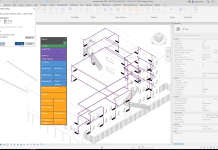PBC Today explores how the Common Data Environment (CDE) strengthens collaboration across the AEC industry and allows for seamless data sharing
A Common Data Environment (CDE) is a solution for businesses and teams, where they can share important information and data. By collaborating and sharing data, CDE is a clear and concise way for companies to be organised and for progress on BIM and construction projects to be seen.
CDE is a single source for information, it creates a facility where members from every team can access and add to the project.
CDE compromises of four main parts, including:
- Work in progress
- Shared
- Published
- Archive
CDE in practice
Using a CDE is not a new concept, but a tried and tested approach to the built environment. Recently, Laing O’Rourke began using Asite’s CDE to lead the clean-up following the devastating bushfires across New South Wales in Australia. The use of CDE in the bushfire clean-up allowed team members from across the project to locate, edit and manage the data in one shared location.
Last year, Heathrow Airport put CDE at the centre of its Information Management strategy. Excitech were appointed to a 7-year contract to lead a consortium for Heathrow Airport, using GroupBC and Autodesk’s CDE solutions.
Earlier this year, GroupBC’s CDE software was chosen to be the core source of organisation and information for Birmingham Airport expansion.
Stuart Bell, sales & marketing director at GroupBC, said: “GroupBC’s CDE is widely used in the owner-operator space due to its industry-leading modern interface, rapid deployment and fast return on investment.
CDE and BIM compliance
A common data environment adheres to guidelines outlined in the PAS 1192 and BS 1192 documentation. These guidelines highlight what needs to be done to achieve BIM Level 2 compliance on projects.
Part of the PAS series, PAS 1192 reveals the set of requirements for achieving BIM Level 2 in the construction industry. The PAS documents aim to establish a framework for collaborative working and information requirements.
BS 1192 details the method for the development, organisation, and management of information. It outlines a stringent process for collaboration and a specified naming policy.
Asite defines this as: “BIM Level 2 compliance requires projects to work collaboratively and a process by which project members can manage the information specific to their project.
“This collaboration also needs to be coordinated between various systems and project participants.
“Therefore, in order to work within a BIM-enabled environment, a CDE should be a main priority for the project team.”
Content ownership of CDE
When it comes to the data shared in a CDE, it is important to remember who owns the content shared. The party who provide the data own their own content.
Richard McPartland, editor of theNBS, said: “Typically team members will licence their contributions for use by the client for a prescribed purpose (ie. generating the federated model to the level of detail contractually set out in Employer’s Information Requirements).
“In turn, clients can then licence the range of models fed back to the CDE for use by other members of the project team for their requirements.
“Ownership may change as the project progresses and decisions are made – objects specified by the designer, for example, will be swopped out by sub-contractor(s) with particular manufacturer’s objects, for example. The information manager must be mindful of these changes of status.”
Why it matters
Joan Allen, product lead, construction records center of excellence at Autodesk wrote about the challenges faced in using a CDE and how to overcome these.
In the Autodesk feature, ‘What’s a Common Data Environment and Why It Matters’, Allen said: “Unfortunately, many teams struggle to manage and disperse information effectively.
“The poor management that inevitably results for companies that don’t have a system in place can lead to errors, rework, missed deadlines, cost overruns, bruised feelings, and even litigation.
“The idea of a common data environment is quite appealing, but the reality of what most construction teams are working with can be less than ideal.
“Many existing challenges make the execution of projects on-time and on-budget, without siloing and with seamless collaboration across niches, more challenging to achieve.”
Allen identifies the following points as reasons to adopt a common data environment:
- Enhanced collaboration: If used correctly, digital technologies have the ability to improve collaboration. That means that all project data and information needs to flow into and be updated in one centralized system. This leads to improved coordination and teamwork, both internally and across teams.
- Creates a single source of truth: One reliable place for team members to access real-time plans, changes, and data leads to better decision-making and insight across projects and even company-wide.
- Improves efficiency and quality: Common data environments reduce the need to manually recreate data, which leads to reduced input errors and lost information.
- Lowers risk: A CDE lowers risk with better transparency and insight into the entire project landscape. Over time, this enables continuous improvement and predictability.
- Strengthens security: With a CDE, administrators and IT professionals have better control of data and information, creating more security.
She concludes: “A common data environment sets your businesses and projects up for success today by allowing your team to optimise and utilise the information when it matters most.
“Adopt a common data environment to ensure that your approach to projects and collaboration remains strong from design through operations.”
Additionally, in 2016, Adrian Burgess, technical director at PCSG wrote about why CDE doesn’t have to be a complicated solution in his article for PBC Today, said: “Every client and every project are different; each supplier has different ways of working and as a result, the CDE can take many different forms.
“The most common misunderstanding is that the CDE is a single technology, platform or system that you buy off the shelf.
“The reality is very different of course, a CDE is actually made up of a number of information management systems, that when it comes to practical implementation, are often owned by a number of different participating organisations.”
By using a CDE, team members have the ability to enhance their work with the potential to complete projects much more efficiently. Digital planning is forever adapting and using a CDE allows companies to develop with it.















Good stuff, but dont forget that the relevant standard now is ISO 19650, not PAS 1192. Also there is no ‘Level 2 BIM’ package any more: you use what you need. CDE’s remain a big issue however as each party to the project tends to have their own favourite and moving information between them is testing the limits of interoperability. The UK BIM Alliance is working on the issue and updating guidance regularly.